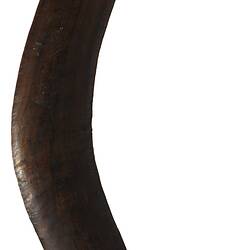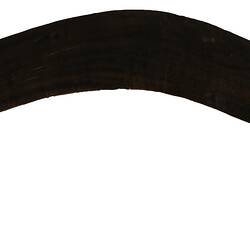Summary
Barkindji man 'King Billy' made and used this wantyi (returning boomerang) and a number of other tools including two clubs, a shield and a yamma (shovel), before giving them to one of the first European settlers on the Darling River, New South Wales in 1860.
It is important to note that the concept of 'King' was introduced and imposed on Aboriginal society by the white invaders as a way of conferring importance and status to Aboriginal men and women who distinguished themselves as useful allies to the colonising project. The people chosen by white authorities to hold this title, whilst sometimes being natural leaders in their communities, were often not considered 'Kings' or 'Queens' in their own communities and did not hold autonomous rights to decision making, a concept foreign to Aboriginal culture. The names given along with the title of 'King' or 'Queen' were often generic European names.
The wantyi (boomerang) that 'King Billy' made is a returning wantyi. This type has a great curve in relation to its length, and the arms are slightly twisted to produce the aerodynamics for returning flight. Skilled hunters can throw a wantyi up to 200 metres; spinning through the air, it is lethal to large upright prey such as emu or kangaroo.
Aboriginal men made wantyi in different shapes and sizes, depending on factors such as available wood, intended purpose of the implement and the geographical features of the country. Wantyi were not used universally across Australia, but in many regions Aboriginal men have long been making and using various shaped wantyi for countless generations. Images of wantyi exist in rock art dating back tens of thousands of years, including in areas of northern Australia where they are no longer made and used.
A branch or root with the appropriate shape and grain is chosen, as a natural wantyi shape in the grain of the wood, means the tip is less likely to break when it hits the ground. The piece is removed from the tree or bush and carved further into shape. Heat or moisture is applied to make the wood suppler, so it can be bent and shaped into its final form before being smoothed and greased with animal fat.
Physical Description
Asymmetrical double curve wooden boomerang with tapered ends. Plano convex in cross section. Both surfaces are smooth and undecorated.
Significance
The Barkindji people are the recognised traditional owners of the area comprising the lower Darling River which they call the Barka, Barkindji literally meaning "people of the Barka".
In 2015, after an intensive 18-year fight, the Barkindji people won their Native Title claim which involves pockets of land spread across 128,000 square kilometres of Barkindji country which extends from the South Australian border to Tilpa in the east, Wentworth in the south, north almost to Wanaaring. Within this huge area lie the towns of Broken Hill, Wilcannia and Menindee.
Barkindji cultural ambassador and respected artist Uncle Badger Bates continues to use and pass on woodworking techniques and art styles taught to him by his Elders which have survived for hundreds of generations. Uncle Badger holds and shares a wealth of knowledge on the subject of identity, culture and stories of the land represented in specific Barkindji designs.
More Information
-
Object/Medium
Boomerang
-
Maker
-
Cultural Groups
-
Locality
-
Date Produced
-
Collector
-
Object Measurements
810 mm (Length), 180 mm (Width), 20 mm (Height)
-
Classification
-
Date Made
-
Maker
-
Clan/Language Group
-
Place Made
-
Indigenous Region
-
Keywords
-
Collection Names
-
Type of item
-
Discipline
-
Category
-
Collecting Areas


